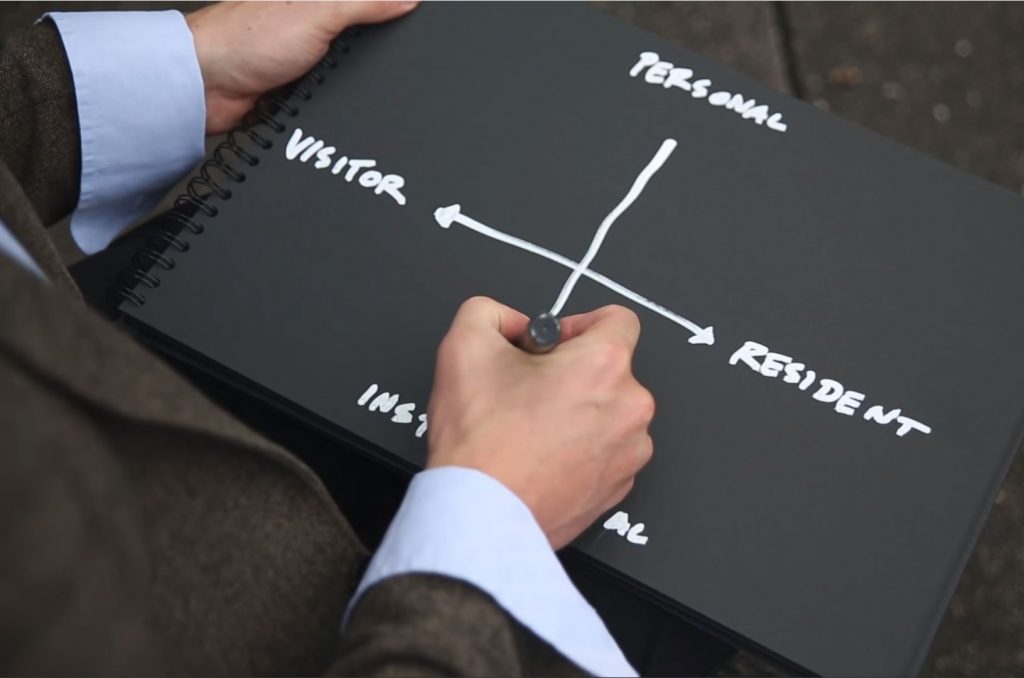Session 2: Visitors and Residents
To do this session
✓ Complete the required readings of linked resources, videos and websites and explore the recommended reading resources
✓ Create a video
✓ Consider the reflection questions
Session Introduction
Exclamations like these have been permeating the education landscape since Marc Prensky’s highly influential “Digital Natives, Digital Immigrants”. This is not included in the reading list because it’s contentious and misleading. We now know that age is not a good determinant of technical expertise and that no matter how old you are, a scaffolded, critical approach to tool use is essential to your development. Truncano (2016) touches on this on his article Revisiting the Digital Native Hypothesis.
Are there other ways we can describe and develop our skills online? This session we will move past the tired binary of digital natives into a more helpful framework of Visitors and Residents. We will examine our own behaviours and identities online using open web and institutional tools and where we spend most of our time. Institutional tools could be where you work and/or study. This graph will be different for everyone and should grow and change over time. David White uses a video production team to show us his visitors and residents map. Not all of us have a professional crew with lighting and equipment waiting to record us and so we need to look at other ways we can make videos that are still high quality but require far less resources. In this course, the goal is to build your current expertise and toolkit so there is maximum flexibility in your approaches. If there’s a different way you would like to make a video, feel free. Take a moment to skim [Session 8: Looking at Video] to get a sense of some recommendations about video creation. Also visit the [page on screencasting] to get a sense of the different options available to you.
Learning Outcomes
By the end of this session you should be able to:
- identify self on the Visitors and Resident spectrum;
- describe strengths and limitations of your current online presence;
- select an appropriate video creation tool based on your experience and comfort level;
- create a short introductory video; and
- situate yourself within a community of diverse peers to build community.
Rationale
As in the first session, we are still trying to get to know each other, and to some extent, get to know ourselves! Creating a short video is a very useful skill that can be used in many contexts as an online teacher.
Connection to Theory
The principles of adult education are rooted in autonomy, mastery, and self-direction. It is essential that you reflect upon your perspective as an online citizen before you can begin teaching online.
Connection to Practice
The tools and assessments we use and create should be applicable to you as teachers. Try to imagine how you would or could use any of these activities in your own courses. If they are not useful, reflect on why and what and how you would change to make them better.
Session Resources
- Session 8: Looking at Video
- Screencasting on your desktop
- Trucano, M. (2016). Revisiting the Digital Native Hypothesis. World Bank Blog.
- White, D. S., & Cornu, A. L. (2011). Visitors and Residents: A new typology for online engagement. First Monday, 16(9).
White, D (2014). Visitors & Residents Video Part 1: Introduction. JiscOnline (Transcripts for all videos)
White, D (2014). Visitors & Residents Video Part 2: Credibility. JiscOnline
White, D (2014). Visitors & Residents Video Part 3: Open Practice. JiscOnline
Learning Activities
Tasks
Create a 2 minute Introductory video describing your visitor vs resident profile. You can create your video any way you like.
Watch this more detailed explanation of how to approach your mapping.
Quiz
Reflection
Here are some guiding questions to help you structure your reflection for this week:
- How is this framework helpful when considering your activities on the web? What are its shortcomings?
- Did you discover anything new about yourself?
- What challenges did you encounter in creating your video?
- What other types of introductory prompts would be a good bridge for creating intro videos?
Bridge to Next Session
Next week we will start our creation process beginning with our learners, who they are, what they need, and what motivates them.


